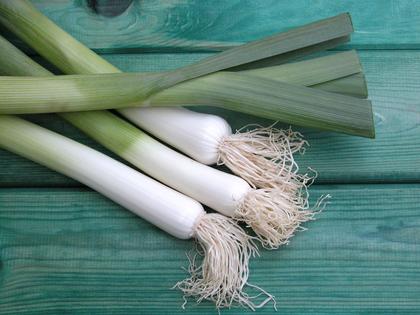Environmental Nutrition: Take a look at leeks
Leeks (Allium porum) are part of the Allium family, along with onions, garlic, shallots, and scallions. In fact, they look like giant scallions -- small white bulbs and tall (about 12 inches), layered stalks, topped with green, flat, fanned leaves.
The folklore
Native to the Mediterranean and the Near East, leeks have been cultivated for thousands of years. Ancient Greeks and Romans used them for food, and medicinally, for nosebleeds and sore throat. Roman Emperor Nero ate them to improve his singing voice, earning him the nickname Porophagus, or leek eater. As the National Emblem of Wales, the Land of Song, leek and daffodil corsages are donned on St. David's Day each year to honor their patron saint. The subtle flavor of the onion-like leek, combined with its not so subtle nutrient punch, is used both as an herb and a vegetable, a favorite in European and Asian cuisines.
The facts
Like their Allium cousins, leeks are rich in health protecting plant compounds, including the flavonols kaempferol and quercetin, which are concentrated in the bulb and lower leaves. A one-cup serving also packs more than half the Daily Value (DV) of vitamin K, important for blood clotting, as well as 30 percent DV of vitamin A, essential to healthy vision.
The findings
Most Allium research has been done on onions and garlic, but leeks contain many of the same healthy components, including sulfur compounds, which have a wide range of benefits, such as antibiotic effects, antiplatelet activity, and anticancer properties (Critical Reviews in Food Science and Nutrition, 2015). Consider using organically grown Alliums, including leeks, when you can. According to the Journal of the Science of Food and Agriculture (2016), organically grown onions retain higher levels of important plant chemicals, like flavonoids, and have significantly higher antioxidant activity compared to conventionally grown onions.
The finer Points
Select leeks as you would scallions -- firm, smooth bulbs, straight white necks, and dark green leaves. Smaller leeks, no more than 1 1/2 inches in diameter, are more tender and less fibrous than larger stalks. Refrigerate in a loose plastic bag up to two weeks. To prepare, remove tough, dark green outer leaves. Cut off the root, and slice in half lengthwise. Wash well in a sink of water until all dirt is removed. Try chopped, raw leeks in green, chicken, or tuna salads for bright flavor and fresh crunch. They also pair famously with potatoes in soup, and are a great addition to stir-fries, sautéed greens, omelets, quiche and pizzas.
...continued







